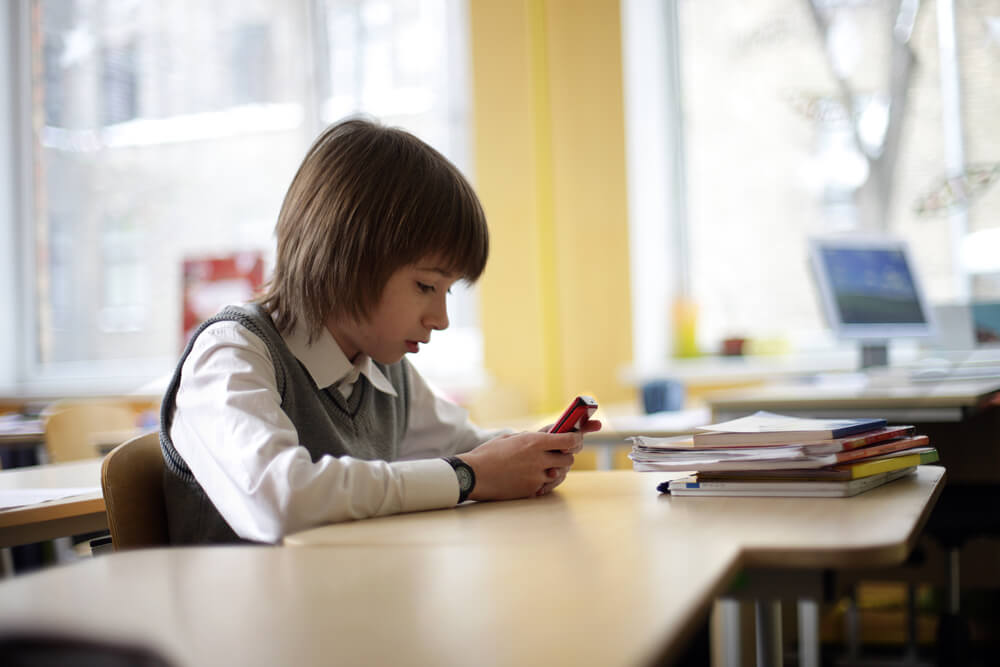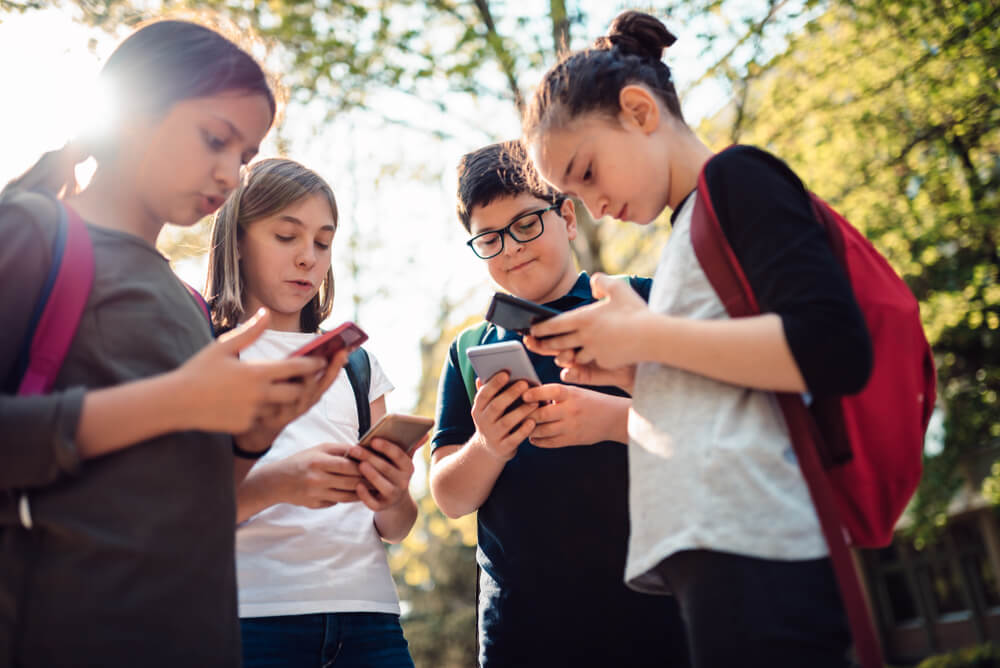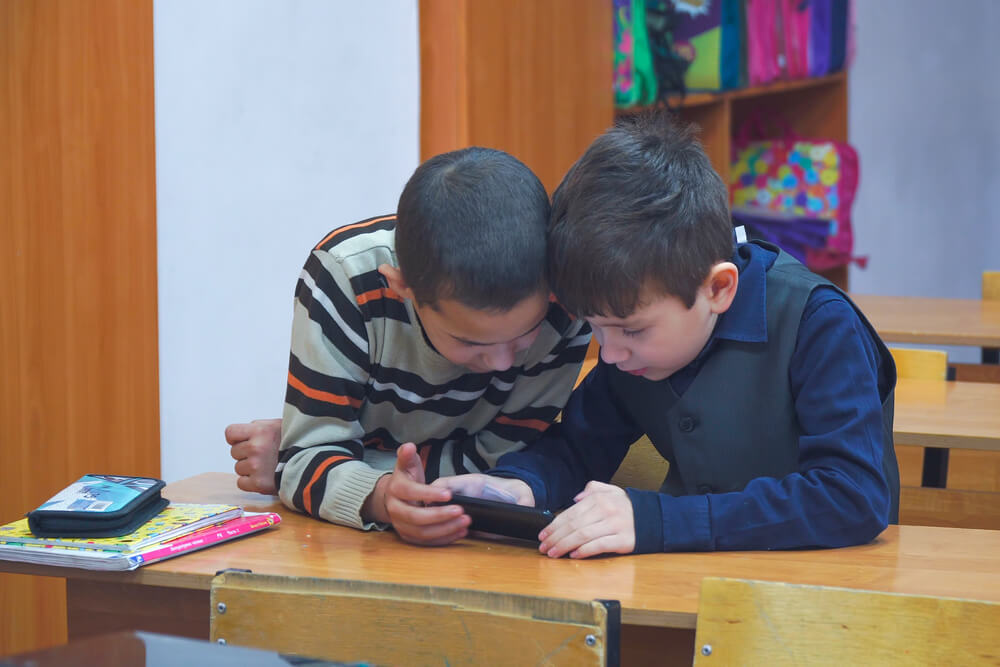Cell Phones in School: Pros and Cons

Exploring the argument of why should cell phones be allowed in schools means recognizing that cell phones and smartphones are a big part of modern life. Many people use them every day, including kids and teens. But there’s still a debate about cell phones in school. In this guide, we’ll look at some arguments for why should phones and mobile devices be allowed in school, while also addressing some common concerns parents may have.
Contents:
- Interesting Facts and Statistics About Cell Phones in Education
- How Cell Phones Can Be Used Effectively?
- What Are the Pros of Allowing Cell Phones in School?
- What Are the Cons of Allowing Cell Phones?
- Are There Any Alternatives?
- Should Kids Have Cell Phones in School?
- FAQs
Interesting Facts and Statistics About Cell Phones in Education

iVazoUSky/Shutterstock.com
Before we look at some of the pros and cons of cell phones in school, let’s look at some statistics to get a clearer picture of the situation.
- 53% of children will own a smartphone by the age of 11 in the US
- That number increases to a whopping 95% in teenagers
- Surveys show that as well as passing the time, 83% of kids use their phones to learn
- Cell phones are the favored communication tool among modern teens
- 41% of teens from lower-income households use their phones to access the internet
- Studies show that learning on mobile devices can boost productivity by over 40%
- Teens can spend over 7 hours a day looking at screens
These are just some of the many, many statistics about cell phones among teens and in the education sector. From this, we can see that mobile and cellular phone technology is a big part of life for today’s teenagers, and cell phones in school do have the power to provide super educational opportunities.
At the same time, with so many kids spending hours a day staring at their phone screens, there’s also a risk that a phone in school could be too much of a distraction. This means that authorities need to weigh up the pros and cons before deciding about banning or allowing phones.
How Cell Phones Can Be Used Effectively?

Ground Picture/Shutterstock.com
Many parents and teachers worry about the risks or downsides associated with using cheap phones at school. However, there are plenty of ways in which children can use these devices for educational and beneficial purposes.
Educational Apps and Games
One of the most obvious ways in which cell phones can be used effectively for education is through the many educational apps and games out there. Cell phones in school can act as powerful learning tools. Mobile app stores are filled with educational content for kids of all ages.
There are apps designed to help kids learn languages, for example. There are also tools and games to help with every school subject, from math to geography.
Related: The 30 Best Educational Apps for School.
Digital Learning Materials

Anna Jurkovska/Shutterstock.com
Giving kids access to their phones at school allows them to use an almost endless library of digital learning materials. There are countless educational documents online, from scientific research papers to exam tips and more.
This can be very beneficial in a school environment. If a child doesn’t quite understand a subject, their teacher can help them by sharing digital learning materials that explain the idea in other ways.
Videos, Podcasts, and More
Every child has their own way of learning. Some like to learn by repeating and memorizing information over and over. Others are more visual learners and want to see ideas and concepts represented with images to get a strong understanding of how they work.
A great thing about using phones and other devices is that they can access all sorts of different digital materials. There are videos about scientific processes, podcasts discussing literature, and long-form articles on mathematic principles, for example.
Cell Phone eReaders
Reading is one of the crucial skills that all children are taught during their early school years. Being able to read well is so important in later life. This skill allows children, teens, and adults to read and understand countless resources, from books to articles and encyclopedias.
A great way that phones can be used in schools is as digital e-readers. It’s easy to download an eReading app onto a phone and then read digital versions of books and documents. This also has eco-friendly benefits, as it removes the need for paper or physical versions of books.
Online Encyclopedias

Ground Picture/Shutterstock.com
Another useful way in which phones can be effective at school is by giving kids access to online encyclopedias, like Wikipedia. These educational resources are very powerful, filled with reams of information and knowledge for kids to soak up.
Children can use their phones to look up the different topics they’re taught at school. This can help to deepen their understanding of almost any subject. It also provides supplementary information that the class teacher might not mention.
Screen Control Apps
One of the common problems that people cite when it comes to the impact of cell phones in schools is that they can be a source of distraction. Many parents and teachers worry that kids will spend too much time looking at their mobile devices and not enough time paying attention in class.
However, a way to combat this is to make use of screen control apps. Apps like Kids360, for example, allow you to track and control how much time your child’s device is on, especially during school time.
Collaboration and Group Work
Often, teachers put kids into groups and ask them to work together on a project. This is a great way for kids of different ages to not only build new social bonds but also develop their teamwork skills.
Phones can be helpful and powerful tools for collaboration. They facilitate communication between the different team members, letting everyone participate, even after school when the various team members say goodbye and go home for the day.
Related: What Age Should a Kid Get a Phone? The Ultimate Guide to Deciding.
What Are the Pros of Allowing Cell Phones in School?

Zivica Kerkez/Shutterstock.com
Clearly, when it comes to phones in schools, there are both pros and cons. Let’s take a look at some of the advantages.
A Powerful Learning Tool
One of the best benefits of allowing cell phones in school is their incredible potential for educational benefits and stronger learning.
As shown above, there are lots of ways that phones can be used for learning. They give access to eReaders, educational apps, online encyclopedias, and more.
An Additional Security Measure
Another benefit of letting kids take phones to school is for their own safety. If any kind of emergency situations or safety concerns happen, the child will be able to make a call and get help or contact their parents.
Not only that, but phones can be helpful for safeguarding kids outside of school, as they make their way home. Parents can use the Findmykids app to track their child’s location and keep them secure.
Download the Findmykids app today for free and be sure your child is safe wherever they are.
Communication with Friends and Family

Ground Picture/Shutterstock.com
Despite having so many different uses nowadays, the primary purpose of a phone is for communication.
Phones at school can help kids keep in touch with one another, work together on group projects, and build strong friendships and social skills.
Organization
Many students struggle to stay organized. It can be hard to keep track of homework, schedules, assignments, exams, and so on.
Phones make organization easier. They come with calendar apps and other handy tools to help kids organize their lives and become more independent.
Saving Schools Money
Phones can also provide benefits for the school itself. Instead of having to spend lots of money on school devices like tablets or iPads, school staff can simply ask students to use their phones.
eReader apps can remove the need for investment in books, and phones could therefore help schools with limited budgets or resources.
Helping Children from Lower-Income Homes

Proshkin Aleksandr/Shutterstock.com
Another financial benefit of phones at school is that they might be able to help kids who come from lower-income homes.
Some kids don’t have internet access or computers at home. Being able to use a phone at school can give them the knowledge and tech skills they need to succeed later in life.
Teaching Kids Tech Skills
Technology is an integral part of today’s world. Kids will need to know how to use various technological tools like phones, computers, and the internet as they grow up.
Bringing phones to school will help to level the playing field and give all kids the chance to learn about how to their devices in the best ways to access knowledge and learn skills.
Teaching Digital Responsibility
Technology is an integral part of today’s world. It’s essential for children to know how to use various technological tools like phones, computers, and the internet in daily life as they grow up.
The presence of cell phones at school gives teachers the chance to teach children about digital responsibility. It can teach them when it’s allowed to use their phones and how to use them in a way that is respectful of others.
What Are the Cons of Allowing Cell Phones?

Ground Picture/Shutterstock.com
As well as the pros listed above, there are also several cons to take into consideration regarding phones in schools. Did you know that 43% of high schools and 77% of middle schools ban phones from schools in the US? There is a large divide between school districts about whether to allow phones during school hours. Here are a few of the big concerns.
A Distraction
One of the big issues that many people talk about with phones in schools is the risk of them becoming a distraction. Kids could start looking at their phones while the teacher is talking and miss out on valuable information, for example. They could also cause a classroom disruption if a student receives a phone call during class, taking attention away from the teacher.
There’s also a risk of kids being less likely to interact and socialize together if they’re too distracted by their screens and devices, which can also impact their mental health.
However, this disadvantage can be easily dealt with. For example, you can install the Kids360 app and make a schedule for using the gadget—restrict access to games during school and before going to bed and monitor which applications and how long the child is using.
Mental Health Effects and Addiction
Some studies have shown that phones could pose mental health challenges for kids and teens. It’s even possible for children of varying ages to develop mental health issues, addictions, or dependencies on their devices, especially when scrolling on social media platforms.
This is why phone usage needs to be carefully monitored, controlled, and balanced. If a child is allowed to use their phone non-stop, they could easily become addicted to them.
Possible Cyberbullying

Daisy Daisy/Shutterstock.com
Bullying has always been a big problem in schools across the globe. It has changed form over the years, with cyberbullying becoming more prevalent in modern times.
With cyberbullying, bullies can use the internet and technological devices, like phones, to send harmful messages or spread false rumors about their peers. This can be very damaging to the victims.
Read also Children and cyberbullying: what is it and how to stop it?
Risk of Cheating
Another possible downside to consider with allowing access to cell phones in schools is the risk of cheating. During an exam, for instance, a student could use their phone to look up the answer to a question.
This kind of behavior could damage the integrity of the examination process. It could also make children too dependent on their devices and cause them to get false grades that are not reflective of their true abilities.
Potential for Misuse
Of course, with any internet-connected device, there’s also a risk of phones being misused by children. Instead of using them for educational purposes, kids could simply play games, watch videos, or find inappropriate digital content.
There’s also a chance of children being able to access unsuitable content on their phones via the internet. For this reason, any phone usage at school would need to be carefully monitored.
Are There Any Alternatives?

EZ-Stock Studio/Shutterstock.com
If, after weighing up the pros and cons of phones in schools, you feel that phones should be banned or strictly controlled, you might like to consider an alternative. So, are there any other devices out there that can provide similar benefits and uses?
In general, the only alternatives to phones are other devices that function in a similar way, like GPS and smartwatches, or laptops and tablets. These devices allow access to educational materials and apps, but also have many of the same risks and downsides as phones.
Choose a GPS watch for a child right now and be calm for the safety of your child wherever they are!
Should Kids Have Cell Phones in School?
Everyone will have their opinion on whether school boards should ban phones from schools or allow them. However, after weighing up the pros and cons, it’s arguable that the benefits of phones outweigh the risks, and kids should be allowed the opportunity to use their phones in certain ways at school.
20 Reasons Why Cell Phones Should Be Allowed in School
There are plenty of benefits of cell phones being allowed in schools. In this digital age, they can act as powerful learning tools for students in schools that allow digital devices to be used. While it’s a common topic of discussion amongst school boards and school administrators, allowing smartphones in schools is one of the be one of the best educational tools available.
- Access to Educational Apps — Phones give students access to thousands of apps that support learning in every subject.
- Digital Learning Materials — Students can instantly access education tools, online textbooks, PDFs, research papers, and other learning tools.
- Personalized Learning — Phones support different learning styles through videos, podcasts, articles, and interactive content.
- Use as eReaders — Phones can replace physical books and reduce the need for printed materials.
- Boosts Productivity — Studies show that learning with mobile devices can increase productivity by over 40%.
- Encourages Independent Research — Students can explore topics of interest beyond what is taught in class.
- Enhance Tech Skills — Regular use of phones helps students improve their digital literacy and tech competence.
- Teach Digital Responsibility — School staff can guide students on appropriate and responsible phone usage.
- Promotes Organization — Calendar and reminder apps help students manage homework, assignments, and exams.
- Safety and Emergency Contact — Phones allow students to quickly contact parents or emergency services if needed.
- Parental Tracking for Safety — Apps like Findmykids let parents track their child’s location during the school day for peace of mind.
- Reduces School Costs — Students using their own devices can lessen the need for schools to invest heavily in physical books and technology.
- Supports Differentiated Learning — Students can work at their own pace and access materials suited to their abilities.
- Builds Communication Skills — Phones in school can help students connect and collaborate more effectively with peers.
- Reduces Paper Usage — Digital resources on phones reduce reliance on paper, supporting sustainability.
- Prepares Students for the Future — Regular use of phones in academic settings mimics how they will use technology in the workplace.
- Encourages Problem-Solving — Students can troubleshoot and solve issues using online resources.
- Increases Student Engagement — Interactive tools and content available on phones can make lessons more engaging.
- Fosters Innovation — Access to modern technology in the classroom can inspire creativity and new ideas.
- Facilitates Instant Feedback — Students can take quizzes or assessments on their phones and receive immediate results.
These technological tools are part of the world, and kids will use them throughout their personal lives, regardless if school officials implement cell phone bans. By bringing them into the school environment, it should be easier to teach children and teens the right ways to use their phones for educational purposes rather than simply as distractions, giving them valuable knowledge and skills they can take into later life.
FAQs
Why should students be allowed cell phones in school?
Cell phones are more than just tools to communicate with peers; they are also powerful educational tools that allow students to access a variety of learning materials while also learning about digital responsibility, especially in an academic or professional setting.
How do phones make schools safer?
When school leaders allow students to have access to cell phones at school, they have an immediate connection with parents and guardians in case of an emergency.
What are the positive effects of mobile phones on students?
Some of the positive effects seen when kids have mobile phones in school include improved collaboration, boosted productivity, level of security, accelerated learning, and improved digital literacy.
The picture on the front page: BearFotos/Shutterstock.com
Проверьте электронный ящик



















